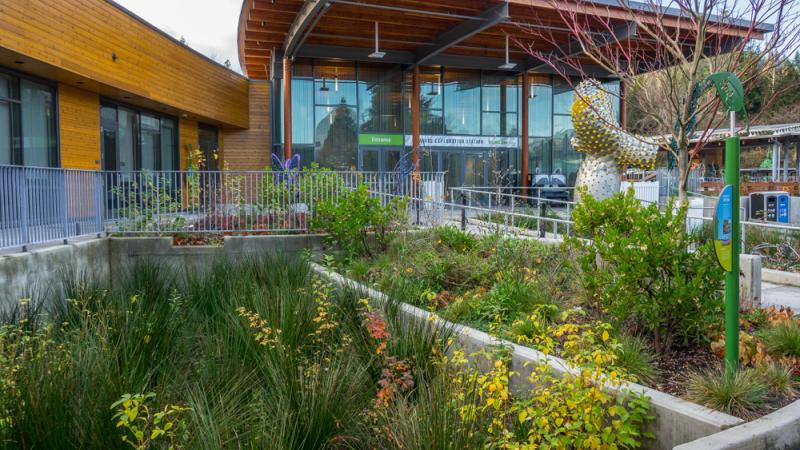Zoo education center earns national green design award

American Institute of Architects recognizes environmental achievement at new center
The Oregon Zoo's new education center — designed to inspire young minds and serve as a regional hub for conservation — has added another honor to its growing list of awards and accolades: an American Institute of Architects COTE Top Ten Award, one of the architecture industry's highest honors for sustainable design excellence.
"We are deeply honored by this recognition," said Dr. Don Moore, Oregon Zoo director. "Our aim is to create a better future for wildlife, and a great first step is making sure our own operations and building practices are environmentally sound."
The center — designed by Portland-based Opsis Architecture — also earned LEED Platinum certification from the U.S. Green Building Council last fall, as well as AIA Portland's prestigious "2030 Architecture" award for design excellence aimed at reducing greenhouse gas emissions.
Earth-friendly design features at the center include the following:
Improved stormwater management
Rain gardens capture, slow down and clean stormwater before releasing to the Willamette River. Rainfall from the roof is routed to a 10,000-gallon underground storage tank. The water is then reused for flushing toilets, conserving potable water use.
Solar panels
The center features 760 solar panels on its roof and on the nearby zoo train platform, in part made possible with funding support from PGE's Renewable Development Fund program customers.
FSC-certified wood
Forests are home to 80 percent of the world's terrestrial biodiversity and they help to stabilize the earth's climate. By using wood certified by the Forest Stewardship Council, the center is helping to limit clear cuts, restrict the most hazardous chemicals and reduce erosion along rivers.
Energy-efficient lighting and HVAC systems
High-efficiency LED lighting and HVAC systems run through a digital control system. The center also features energy-efficient radiant floor heating.
Native plants and green roofs
Landscaping at the center includes 90 species of Willamette Valley native plants, which require less irrigation and provide food and shelter for local wildlife. The Wildlife Garden shelter and "bee hotel" both feature green roofs.
Bird-friendly lighting and windows
Millions of birds die each year from flying into windows, and Portland's location along the Pacific Flyway makes spring and fall migration periods especially deadly. At the education center, bird-friendly lights and fritted glass — identified with help from the American Bird Conservancy — help prevent window strikes.
Salvaged building materials
The landscape gates and wildlife garden shelter were built out of wood salvaged from the decommissioned Elephant Museum building. Pavers in the Wildlife Garden are salvaged from the old Elephant Plaza picnic area.
The Education Center — the fifth of eight major projects funded by the 2008 zoo bond measure promoting animal welfare and sustainability — provides a welcoming entry for the thousands of children who participate in zoo camps and classes each year, and serves as a regional hub, expanding the zoo's conservation education programs through collaborations with the U.S. Fish and Wildlife Service and other partners.
All of the zoo bond projects have a goal to achieve a minimum of LEED Silver certification, and the zoo's Veterinary Medical Center and Elephant Lands have already been certified LEED Gold.
More News

Rescued cougar cubs are venturing out
A pair of orphaned cougar cubs, rescued and brought to the zoo by Washington Department of Fish and Wildlife staff in November, have begun exploring their outdoor habitat.April 17, 2025

Zoo seeks pika watchers for summer season
The Oregon Zoo is recruiting volunteers for Cascades Pika Watch.April 15, 2025

Zoo convenes action for imperiled elephants
Sabah government representatives joined conservation NGOs, local communities, palm oil producers, and tourism operators this week in the fight to save the world’s smallest elephants from extinction.April 11, 2025

